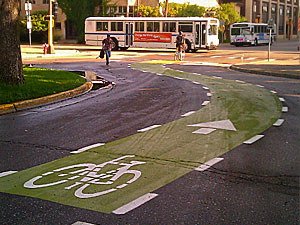On the move with Cyclopath

Navigating the Twin Cities, the U's campuses, and (in time) greater Minnesota by bike just got that much easier. Cyclopath, a navigational aide for bikers in the seven-county metro area, has gone mobile (phone) and it's on the move to expand its collective navigational prowess to greater Minnesota.
Pop an algorithmic wheelie
Take one part MapQuest, one part Wikipedia, pop an algorithmic wheelie, and you've got Cyclopath, a web-based tool made far greater than the sum of its parts by its nature. It's a geowiki—an interactive map updated by its many users, numbering nearly 3,000 and gaining. Like Wikipedia, the tool grows in power with user knowledge and experience.
Bicycling's best
Minneapolis was named "Best Bicycling City in the Nation" according to Bicycling Magazine in 2010, until that pesky Portland bumped us down a notch. And St. Paul isn't too shabby either. Minnesota as a whole was recently ranked the fourth most bicycle friendly state in the nation by the League of American Bicyclists. Nearly 5,000 U faculty, staff, and students consider biking their main mode of transportation to, from, and on UMTC campuses. And why not? The U hosts Nice Ride bike sharing, 6,700 bike hoops, 169 bike lockers, and more. Get pedaling.
Developed several years ago by Reid Priedhorsky, now a graduate of the U's Ph.D. program in computer science, Cyclopath has also gone mobile (free, via the Android platform) thanks to current graduate students Fernando Torre and Phil Brown. The Minnesota Department of Transportation likes it so much that just this summer it awarded a grant to expand Cyclopath's coverage statewide (planned for early 2013). And in mid-August, a new feature was added that allows users to combine bicycling with Metro Transit buses and light rail to plot routes that use multiple modes of transportation.
Here's how it works. Cyclists enter a start and end point and select preferences for their path like distance and "bikeability." Check a box that says "construction," and avoid construction. Check a box that says "traffic," and your route will be one with less traffic. Check a box that says "Use Metro Transit buses when possible,"—a brand new option—and your path is multi-modal. Check a box that says "bike lanes," and Cyclopath will do its best to get you safely to your destination using routes with bike lanes whenever possible. That, in particular, appeals to those wary of competing with vehicles on the road.
"We've surveyed users," says Loren Terveen, director of Computer Science and Engineering and a leader of GroupLens, the U's human/computer interaction and social computing research lab. "One finding is that people told us they've gained confidence in riding because they feel like they can find safe ways to get around."
Staying safe, avoiding construction
Protect your brain
Alas, there is no Cyclopath preference box to check for "ride without a helmet." Your brain is a good thing. Protect it with the U's Helmets and Headlights program, which offers significantly discounted bike safety equipment.
Users can also make changes to inaccurate or outdated map information—something very valuable with LRT construction under way both on the UMTC campus and in the Twin Cities. A road closure in the morning is likely to be factored into Cyclopath by the afternoon.
Another valuable feature of the application are comments left by users for the benefit of others. They range from updates on the conditions of the roads and trails they travel, adding "tags" like "potholes everywhere," or "shortcut here," to points of interest, like "free bike pump by bike racks," or "Al's Breakfast."
Though anyone can use the tool, users who register with a login can receive recommendations from Cyclopath based on past preferences—the technology (known as a recommender system) gets to know what you like. The problem with other navigational tools, says Terveen, is that "data is incomplete, things change, and it's important to let cyclists [give feedback], especially with all the construction going on. This gives people a way to get to campus more easily," he says.
New campus bike center
With the start of the fall semester, the U will start offering great amenities to bicyclists on campus when it opens its first campus bike center in the Oak Street Ramp. The center will feature showers, changing facilities, repair service, a retail outlet, educational opportunities such as bike maintenance classes, and more.
One avid cyclist and frequent contributor to Cyclopath is Lee Penn, an associate professor of chemistry and McKnight Presidential Fellow. Penn is so fond of cycling that she teaches a freshman seminar titled "Chem 1905: My Other Car is a Bicycle," in which she requires students to plot routes using Cyclopath. "And then they are required to ride their routes, and report on their experiences." says Penn. "This is an overwhelmingly positive experience for those students who actually choose some place off campus, and choose a place they really don't know how to get to."
Penn, too, uses Cyclopath, much less for getting around campus and more for getting to "new-to-me" places. "I have occasionally been delightfully surprised to discover new destinations by way of Cyclopath because riders enter interesting places to go."
Asked about her dual interests, she simply explains, "I love chemistry, and I love bikes. I just am a very happy person when I'm on my bike." Cyclopath just makes it that much easier to ride.
